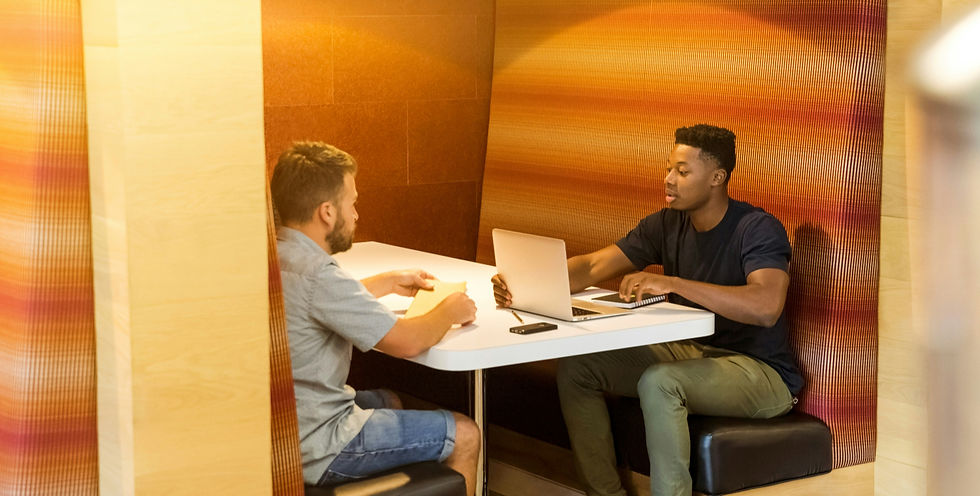Office Design Trends for 2025: Design as a Competitive Advantage
- Raúl G. Molina
- Jan 13
- 4 min read
As we enter 2025, it is clearer than ever that the office is no longer just a physical space to sit and work; it has become an essential part of a company’s competitive strategy. Increasingly, we observe that smartly designed offices, with a clear purpose, are transforming into powerful catalysts for both well-being and productivity. These environments support a wide range of work styles that prioritize focus, and they help attract and retain key talent—an essential asset for the development of the most competitive organizations.
This report summarizes the office design trends that will define 2025, drawing from global corporate design leaders and our own projections. Keep reading to explore the corporate design landscape for 2025.

An Intentionally Designed Office is a Competitive Advantage
Although the corporate real estate market will not change overnight, the design of intelligent, dynamic offices that naturally integrate hybrid work models will become a key competitive advantage over the next decade. The ease with which each organization adopts hybrid work will enable higher productivity levels and will be crucial for retaining top talent. More and more employees now expect not to have to come into the office every day.

Design Around Employee Well-being
In countries like Mexico, the demand for highly skilled and productive employees—those who truly make a difference in companies—continues to outpace supply, and industries are competing to recruit these individuals. Additionally, the individual vision of work has changed. Employee well-being is no longer a "nice-to-have" but has become a priority for companies and an expectation for workers.
In line with this, a key design trend will be the creation of a broader variety of workstations, moving away from the idea of assigned desks. Employees will have the freedom to work in the space that best suits the task at hand (Leesman, The Desk Dilemma).
Workstations Replace Assigned Desks
Offices will adopt a more hospitality-like ambiance, with diverse workstations informed by a thorough analysis of how employees work. This new design vision will consider individual and team concentration needs, as well as creativity, discussion, and reflection activities, to create an appropriate balance of spaces. Workstations will be designed to reflect the frequency of these activities and their ergonomic needs.
For example, if a workstation is expected to be used for one hour, its ergonomics should be suitable for that duration, not for half an hour or two hours, as that could affect employee productivity and flow.

Flexible, Adaptable, and Intelligent Design
A key design feature that architects will consider in 2025 is the implementation of flexible, reconfigurable infrastructure and furniture, allowing companies to adjust their spaces as they learn more about the specific needs of each team.
Just as employee well-being has become an expectation, so has a company’s commitment to sustainability. Companies will aim to reduce their carbon footprints not just through their products and processes, but also in the design of their offices. This will lead to a growing trend in repurposing existing spaces rather than constructing new ones. Moreover, the selection of finishes and furniture will prioritize flexible solutions that can adapt to the company's future needs and be reconfigured over the long term, eliminating the need for costly replacements.
Focus on Fostering Concentration: THE Priority
Spaces that foster concentration, whether for individual work or small team collaboration, will continue to be a top priority. However, these spaces will reflect the lessons learned about the most efficient and productive ways to work in a hybrid environment. They will seamlessly integrate technology tools for digital collaboration with one or multiple people, ensuring that employees can focus without distractions while remaining connected when needed.
Sector-Specific Trends for 2025
Tech Companies:These companies will reinvest in their office spaces with a focus on fostering employee growth by designing offices that encourage the development of both soft skills and technical knowledge (Gensler, Design Forecast 2025).
Service Companies:They will address employee expectations by designing spaces that prioritize physical social experiences, which were lacking in remote workdays (Gensler, Design Forecast 2025).
Consumer Goods Companies (Multi-Brand):These companies will seek flexible office spaces that can expand and adapt to the unique cultures and needs of each of their brands (Gensler, Design Forecast 2025).
Financial Services Companies:Financial firms will create multipurpose spaces to provide employees with more opportunities to socialize, expand their professional networks, and develop their careers (Gensler, Design Forecast 2025).
Corporate Real Estate Market
The corporate real estate market will not be fully transformed in a single year, and the trend of migration from class B and C offices to high-quality class A alternatives will continue. A key factor in this shift will be proximity to convenient transportation options and nearby amenities like restaurants, shops, and communal spaces.
Sessione’s Approach to Office Design
The design of Sessione products is backed by continuous analysis and research, and we share this summary to assist our clients and architects in creating efficient workspaces with clear objectives.
We recommend watching this video by The Wall Street Journal to see some practical examples of how leading companies in their respective fields are applying these trends.
Additional Interesting Resources:
In Conclusion:
As we approach 2025, the office design landscape is shifting towards flexibility, sustainability, and a focus on employee well-being. By embracing these trends, companies can create environments that support both productivity and creativity, attract top talent, and adapt to the evolving needs of the modern workforce.
